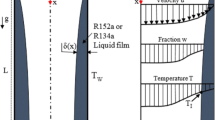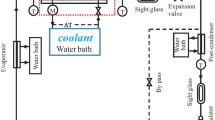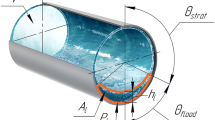Abstract
The Reynolds analogy and its modifications are applied to forced convection laminar in-tube condensation to predict the heat transfer coefficient of R134a by means of well-known two-phase friction factors and agreed void fraction models and correlations explained in the authors’ previous works. The vertical test section is a 0.5 m long countercurrent flow double tube heat exchanger with refrigerant flowing in the inner smooth copper tube (8.1 mm i.d.) and cooling water flowing in the annulus (26 mm i.d.). The test runs are performed at average saturated condensing temperatures of 40 °C (Pr = 0.92) and 50 °C (Pr = 0.97). The heat fluxes are between 10.16 and 66.61 kW m−2 while the mass fluxes are between 260 and 515 kg m−2 s−1 for the vertical test sections. The Reynolds’ model is modified by various two-phase flow models and correlations to account for the partial condensation inside the tube. The refrigerant side heat transfer coefficients are determined within ±30% using the two-phase friction factors of Wallis, Moeck, Fore et al., while all the proposed friction factor correlations for the Reynolds analogy, Prandtl and Taylor analogy, and Colburn analogy predict the experimental friction factor within a ±20% deviation band. The importance of altering the Prandtl number to the Reynolds analogy (Pr = 1) is also shown in the paper.

Similar content being viewed by others
Abbreviations
- A:
-
Inside surface area, m−2
- C p :
-
Specific heat, J kg−1 K−1
- d :
-
Internal tube diameter, m
- f :
-
Friction factor
- G :
-
Mass flux, kg m−2 s−1
- h :
-
Heat transfer coefficient, W m−2 K−1
- i :
-
Enthalpy, J kg−1
- i fg :
-
Latent heat of condensation, J kg−1
- L :
-
Length of test tube, m
- k :
-
Thermal conductivity, W m−1 K−1
- m :
-
Mass flow rate, kg s−1
- P :
-
Pressure, MPa
- Pr :
-
Prandtl number
- r :
-
Internal tube radius, m
- Re :
-
Reynolds number
- S :
-
Slip ratio
- T :
-
Temperature, °C
- u :
-
Velocity, m s−1
- Q :
-
Heat transfer rate, W
- q :
-
Mean heat flux, kW m−2
- x :
-
Mean vapor quality
- y :
-
Wall coordinate
- ΔP :
-
Pressure drop, Pa
- ΔT :
-
Vapor side temperature difference, T sat−T wi, K
- \({\varepsilon_{\rm c}}\) :
-
Conductive diffusivity/viscosity, m2 s−1
- \({\varepsilon_{\rm m}}\) :
-
Eddy momentum diffusivity/viscosity, m2 s−1
- \({\varepsilon_{\rm q}}\) :
-
Eddy heat diffusivity/viscosity, m2 s−1
- ρ :
-
Density, kg m−3
- μ :
-
Dynamic viscosity, kg m−1 s−1
- δ :
-
Film thickness, m
- δ + :
-
Dimensionless film thickness
- α :
-
Void fraction
- τ :
-
Shear stress, N m−2
- ν :
-
Kinematic viscosity, m2 s−1
- corr:
-
Correlation
- exp:
-
Measured
- f:
-
Fluid
- g:
-
Gas/vapor
- H:
-
Homogeneous
- i:
-
Inlet
- l:
-
Liquid
- o:
-
Outlet
- ph:
-
Preheater
- ref:
-
Refrigerant
- sat:
-
Saturation
- SG:
-
Superficial
- TS:
-
Test section
- w:
-
Water
- wi:
-
Inner wall
References
Wallis G.B.: One-Dimensional Two-Phase Flow. McGraw-Hill, New York (1969)
Carey V.P.: Liquid-Vapor Phase Change Phenomena. Hemisphere Publishing, New York (1992)
Maheshwari N.K., Sinha R.K., Saha D., Aritomi M.: Inverstigation on condensation in presence of a noncondensible gas for a wide range of Reynolds number. Nucl. Eng. Des. 227, 219–238 (2004)
Fukano T., Furukawa T.: Prediction of the effects of liquid viscosity on interfacial shear and frictional pressure drop in vertical upward gas–liquid annular flow. Int. J. Multiph. Flow 24, 587–603 (1998)
Moeck E.O.: Annular-dispersed two-phase flow and critical heat flux. AECL 3656, 337–346 (1970)
Fore L.B., Beus S.G., Bauer R.C.: Interfacial friction in gas–liquid annular flow: analogies to full and transition roughness. Int. J. Multiph. Flow 26, 1755–1769 (2000)
Fanning, J.T.: A Practical Treatise on Hydraulic and Water Supply Engineering. Van Nostrand, New York (1877) [Revised ed. 1886]
Darcy H.: Recherches experimentales relatives au mouvement de l’Eau dans les Tuyaux. Mallet-Bachelier, Paris (1857)
Weisbach, J.: Lehrbuch der Ingenieur und Maschinen-Mechanik, Braunschwieg (1845)
Wongwises S., Kongkiatwanitch W.: Interfacial friction factor in vertical upward gas–liquid annular two-phase flow. Int. Commun. Heat Mass Transf. 28, 323–336 (2001)
Soliman H.M., Feingold A.: of fully developed laminar flow in longitudinal internally finned tubes. Chem. Eng. J. 14, 119–128 (1977)
Al-Sarkhi A., Hanratty T.J.: Effect of pipe diameter on the performance of drag-reducing polymers in annular gas–liquid flows. Inst. Chem. Eng. 79, 402–408 (2001)
Choi, J.Y.; Kedzierski, M.A.; Domanski, P.A.: Generalized pressure drop correlation for evaporation and condensation in smooth and microfin tubes. In: Proceedings of IIF-IIR Commision B1, vol. B4, Paderborn, Germany, pp. 1–9 (2001)
Pierre, B.: Flow resistance with boiling refrigerants-part l. ASHRAE J. 6, 58–65 (1964)
Blasius, H.: Grenzschichten in Flüssigkeiten mit kleiner Reibung. Z. Math. u. Phys. 56, 1–37 (1908)
Reynolds O.: On the extent and action of the heating surface of steam boilers. Proc. Manch. Lit. Phil. Soc. 8, 7–12 (1874)
Prandtl, L.: Eine Beziehung zwischen WS.rmeaustausch und. Str6mungswiderstand bei Fliissigkeiten. Zeitschrift far Physik 11, 1072–1078 (1910)
Taylor, G.I.: British Advisory Committee for Aeronautics. Reports and Memoranda, No. 272 (1916)
Colburn A.P.: A method of correlating forced convection heat transfer data and a comparison with fluid friction. Trans. Am. Inst. Chem. Eng. 29, 174–210 (1933)
Ambrosini, W.; Forgione, N.; Manfredini, A.; Oriolo, F.: On various forms of the heat and mass transfer analogy: Discussion and application to condensation experiments. Nucl. Eng. Des. 236, 1013–1027 (2006)
Chitti, M.S.; Anand, N.K.: An analytical model for local heat transfer coefficients for forced convective condensation inside smooth horizontal tubes. Int. J. Heat Mass Transf. 38, 615–627 (1995)
Kim M.H., Corradini M.L.: of condensation heat transfer in a reactor containment. Nucl. Eng. Des. 118, 193–212 (1990)
Dalkilic, A.S.; Laohalertdecha, S.; Wongwises, S.: Effect of void fraction models on the two-phase friction factor of R134a during condensation in vertical downward flow in a smooth tube. Int. Commun. Heat Mass Transf. 35, 921–927 (2008)
Dalkilic, A.S.; Yildiz, S.; Wongwises, S.: Experimental investigation of convective heat transfer coefficient during downward laminar flow condensation of R134a in a vertical smooth tube. Int. J. Heat Mass Transf. 52, 142–150 (2009)
Dalkilic, A.S.; Laohalertdecha, S.; Wongwises, S.: Two-phase friction factor in vertical downward flow in high mass flux region of refrigerant HFC-134a during condensation. Int. Commun. Heat Mass Transf. 35, 1147–1152 (2008)
Dalkilic, A.S.; Laohalertdecha, S.; Wongwises, S.: Effect of void fraction models on the film thickness of R134a during downward condensation in a vertical smooth tube. Int. Commun. Heat Mass Transf. 36, 172–179 (2009)
Dalkilic A.S., Wongwises S.: Intensive literature review of condensation inside smooth and enhanced tubes. Int. J. Heat Mass Transf. 52, 3409–3426 (2009)
Dalkilic, A.S.; Laohalertdecha, S.; Wongwises, S.: Experimental investigation on heat transfer coefficient of R134a during condensation in vertical downward flow at high mass flux in a smooth tube. Int. Commun. Heat Mass Transf. 36, 1036–1043 (2009)
Dalkilic, A.S.; Agra, O.; Teke, I.; Wongwises, S.: Comparison of frictional pressure drop models during annular flow condensation of R600a in a horizontal tube at low mass flux and of R134a in a vertical tube at high mass flux. Int. J. Heat Mass Transf. 53, 2052–2064 (2010)
Dalkilic, A.S.; Wongwises, S.: An investigation of a model of the flow pattern transition mechanism in relation to the identification of annular flow of R134a in a vertical tube using various void fraction models and flow regime maps. Exp. Therm. Fluid Sci. 34, 692–705 (2010)
Dalkilic, A.S.; Laohalertdecha, S.; Wongwises, S.: Validation of void fraction models and correlations using a flow pattern transition mechanism model in relation to the identification of annular vertical downflow in-tube condensation of R134a. Int. Commun. Heat Mass Transf. 37, 827–837 (2010)
Dalkilic A.S., Laohalertdecha S., Wongwises S.: Experimental study of the condensation heat transfer coefficients in high mass flux region in annular flow regime of HFC-134a inside the vertical smooth tube. Heat Transf. Eng. 32, 33–44 (2011)
Dalkilic, A.S.; Laohalertdecha, S.; Wongwises, S.: New experimental approach on the determination of condensation heat transfer coefficient using frictional pressure drop and void fraction models in a vertical tube. Energy Convers. Manag. 51, 2535–2547 (2010)
Dalkilic A.S., Wongwises S.P: A performance comparison of vapour compression refrigeration system using various alternative refrigerants. Int. Commun. Heat Mass Transf. 37, 1340–1349 (2010)
Dalkilic, A.S.; Teke, I.; Wongwises, S.: Experimental analysis for the determination of the convective heat transfer coefficient by measuring pressure drop directly during annular condensation flow of R134a in a vertical smooth tube. Int. J. Heat Mass Transf. 54, 1008–1014 (2011)
Balcilar M., Dalkilic A.S., Wongwises S.: Artificial neural network (ANN) techniques for the determination of condensation heat transfer characteristics during downward annular flow of R134a inside a vertical smooth tube. Int. Commun. Heat Mass Transf. 38, 75–84 (2011)
Dalkilic A.S.: Condensation pressure drop characteristics of various refrigerants in a horizontal smooth tube. Int. Commun. Heat Mass Transf. 38, 504–512 (2011)
Balcılar, M.; Dalkilic, A.S.; Bolat, B.; Wongwises, S.: Investigation of empirical correlations on the determination of condensation heat transfer characteristics using computational numerical methods during downward annular flow of R134a inside a vertical smooth tube. J. Mech. Sci. Technol. 25, 2683–2701 (2011)
Dalkilic, A.S.; Kurekci, N.A.; Wongwises, S.: Effect of void fraction and friction factor models on the prediction of pressure drop of R134a during downward condensation in a vertical tube. Heat Mass Transf. 48, 123–139 (2012)
Chen S.L., Gerner F.M., Tien C.L.: General film condensation correlations. Exp. Heat Transf. 1, 93–107 (1987)
Chisholm, D.: Two phase flow in pipelines and heat exchangers. George Godwin in association with The Institution of Chemical Engineers, London (1983)
Soliman H.M.: On the annular-to-wavy flow pattern transition during condensation inside horizontal tubes. Can. J. Chem. Eng. 60, 475–481 (1982)
Smith S.L.: Void fractions in two-phase flow: a correlation based upon an equal velocity head model. Proc. Inst. Mech. Eng. 36, 647–664 (1969)
Turner, J.M.; Walli,s G.B.:The separate-cylinders model of two-phase flow, paper no. NYO-3114-6, Thayer’s School of Engineering, Dartmouth College, Hanover, NH, USA (1965)
Spedding P.L., Spence D.R.: of holdup in two phase flow. Int. J. Eng. Fluid Mech. 2, 109–118 (1989)
Kline S.J., McClintock F.A.: Describing uncertainties in single sample experiments. Mech. Eng. 75, 3–8 (1953)
Moser K., Webb R.L., Na B.: A new equivalent Reynolds number model for condensation in smooth tubes. Int. J. Heat Transf. 120, 410–417 (1998)
Scarborough J.B.: Numerical Mathematical Analysis. Oxford & IBH, New Delhi (1966)
Author information
Authors and Affiliations
Corresponding author
Rights and permissions
About this article
Cite this article
Dalkilic, A.S., Kundu, B. & Wongwises, S. An Experimental Investigation of the Reynolds Analogy and its Modifications Applied to Annular Condensation Laminar Flow of R134a in a Vertical Tube. Arab J Sci Eng 38, 1493–1507 (2013). https://doi.org/10.1007/s13369-013-0595-0
Received:
Accepted:
Published:
Issue Date:
DOI: https://doi.org/10.1007/s13369-013-0595-0




